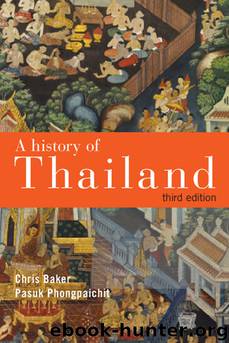A History Of Thailand by Baker Chris

Author:Baker Chris [Baker Chris]
Language: eng
Format: epub
Publisher: Cambridge University Press
Published: 2014-04-25T14:00:00+00:00
Peasants into the market
Development also transformed the old paddy tracts. After 1945, international agencies were interested in expanding Thailand’s rice surplus to help feed the war-torn countries of Asia immediately, and the growing population of Asia in the longer term. Van der Heide’s 1902 plan to regularize the water supply of the whole Chao Phraya delta was revived and updated with international expertise and sponsorship. The Chainat dam at the head of the delta was completed in 1957, and two more dams on the upper tributaries were added over the next decade. These dams lessened the risk of seasonal flooding or scarcity. The rivers and an extended canal network spread the flow from the dams more evenly across the whole delta zone.
The initial impact of this big investment was disappointing. But the 1960s’ ‘Green Revolution’, sparked by research on rice technology in the Philippines, combined with greater water security to bring major changes. New paddy seeds adapted to Thai conditions were developed and distributed in the 1960s. Fertilizer and pesticide use rapidly increased. Two-wheeled tractors, developed in China and known as ‘iron buffalo’, were locally produced and rapidly replaced their four-legged counterpart. The dams spread the water supply over a long period, the new seeds ripened more quickly, and the iron buffaloes shortened the time for land preparation. Favoured areas, especially around the top and sides of the Chao Phraya delta, could now grow two or three crops of rice a year.
On a lesser scale, government water projects brought the same benefits to other established paddy tracts. The Mae Teng project extended the same principle of stable water supply to the Chiang Mai valley. Dams on the upper tributaries of the Chao Phraya created more secure water supplies along valleys that had been highly prone to seasonal flooding. Barrages improved the usability of the water along the Mun-Chi river system of the northeast. Smaller projects were built in the rice-bowls down the peninsula coasts.
With these innovations, paddy yields per rai in the central plain doubled in 30 years. Rice exports surged again, making Thailand the world’s largest rice exporter. People benefited. The proportion of households below the poverty line in the central region fell from two-fifths in 1962–63 to just one-eighth only 13 years later.
In the mid-1970s, a Japanese anthropologist returned to a village in the upper delta that he had first studied a decade earlier. Then, it had been a recent frontier settlement of smallholder farms using exchange labour and traditional technology. He was amazed by the change over the intervening handful of years. Bullocks had disappeared, replaced by small tractors. Exchange labour had collapsed and professional agents now managed people in labour gangs. Traditional rice varieties had been replaced by the new Green Revolution seeds, nourished with fertilizer and chemicals. Most of all, the anthropologist noted the mental change. Villagers who had described the local rituals to him only a decade ago now exclaimed that ‘the rice spirit is no match for chemical fertilizer’.17
This anthropologist, along with many
Download
This site does not store any files on its server. We only index and link to content provided by other sites. Please contact the content providers to delete copyright contents if any and email us, we'll remove relevant links or contents immediately.
| Africa | Americas |
| Arctic & Antarctica | Asia |
| Australia & Oceania | Europe |
| Middle East | Russia |
| United States | World |
| Ancient Civilizations | Military |
| Historical Study & Educational Resources |
The Rape of Nanking by Iris Chang(3507)
The Sympathizer by Viet Thanh Nguyen(3462)
World without end by Ken Follett(3004)
Ants Among Elephants by Sujatha Gidla(2920)
Blood and Sand by Alex Von Tunzelmann(2606)
Japanese Design by Patricia J. Graham(2552)
City of Djinns: a year in Delhi by William Dalrymple(2130)
Inglorious Empire by Shashi Tharoor(2098)
Foreign Devils on the Silk Road: The Search for the Lost Treasures of Central Asia by Peter Hopkirk(2052)
In Order to Live: A North Korean Girl's Journey to Freedom by Yeonmi Park(2050)
Tokyo by Rob Goss(2014)
India's Ancient Past by R.S. Sharma(1982)
India's biggest cover-up by Dhar Anuj(1979)
The Great Game: On Secret Service in High Asia by Peter Hopkirk(1959)
Tokyo Geek's Guide: Manga, Anime, Gaming, Cosplay, Toys, Idols & More - The Ultimate Guide to Japan's Otaku Culture by Simone Gianni(1941)
Goodbye Madame Butterfly(1930)
The Queen of Nothing by Holly Black(1748)
Living Silence in Burma by Christina Fink(1726)
Batik by Rudolf Smend(1718)
